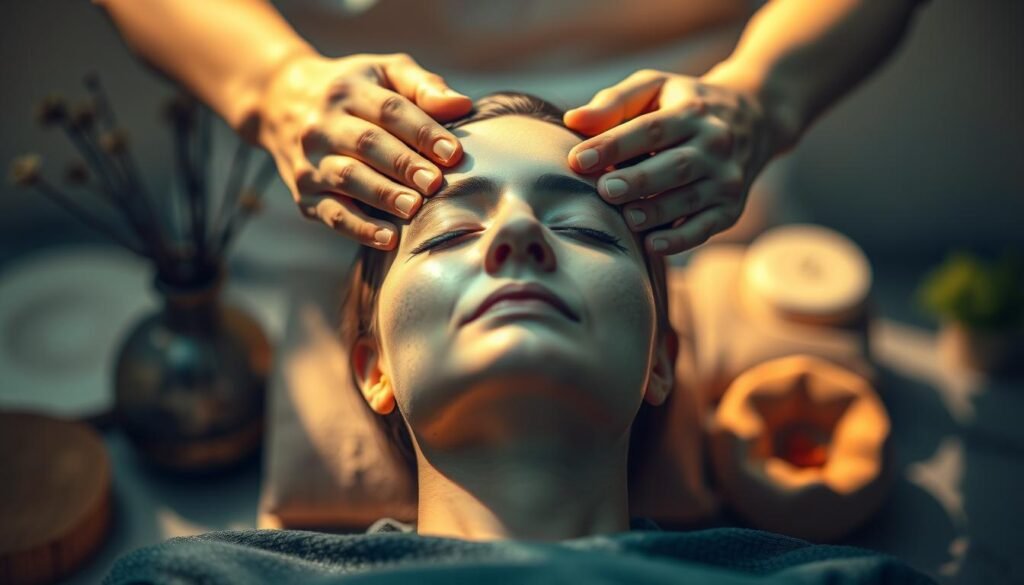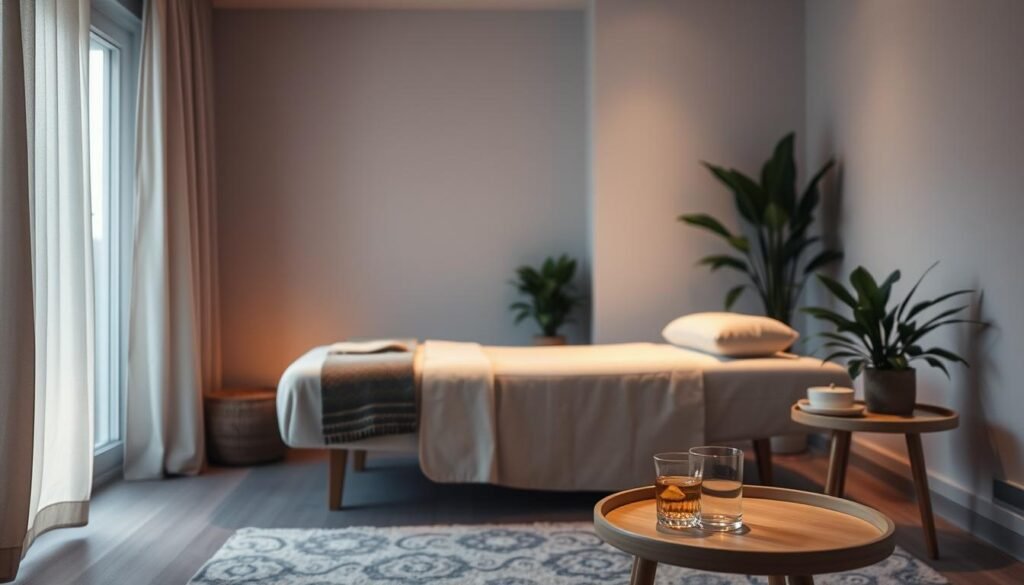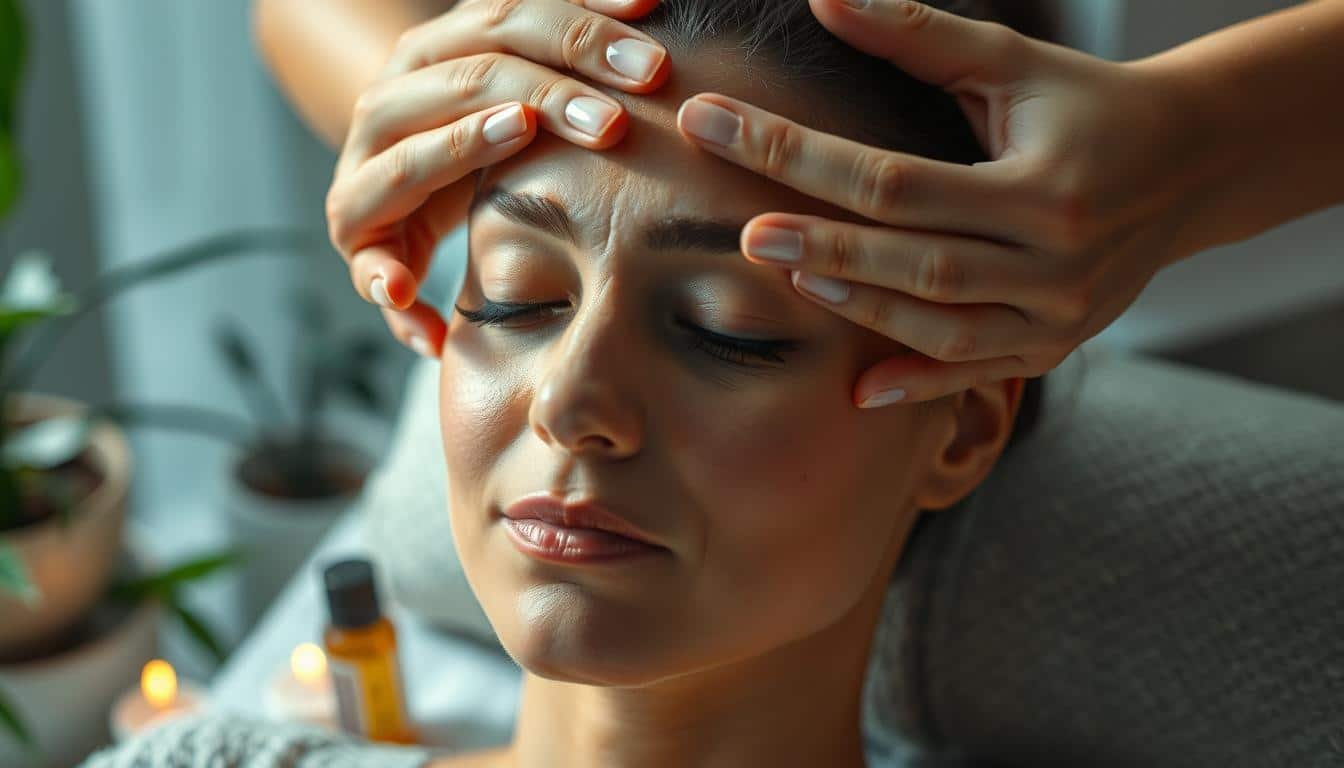Did you know that almost half of the world’s population had headaches last year? That’s a huge number of people dealing with this painful issue. I’ve learned that massage can really help with headaches.
Studies show massage is great for tension headaches and migraines. A small study found that regular massages cut down weekly headaches from seven to two. They also made headaches last half as long, from 8 hours to 4 hours1. These results show how self-massage can help with headache pain.
I’ve found that massaging certain points can really help. Pressing on the temples and neck can ease pain. The LI-4 point, between the thumb and index finger, is also good for headaches2. Gently pressing on this spot for 2-3 minutes can make headaches less intense.
In this guide, I’ll share my own experiences and research on massaging headaches. We’ll look at self-massage methods and pressure points for relief. These can help without needing medication all the time.
Key Takeaways
- Headaches affect nearly half of the global population annually
- Massage therapy can significantly reduce headache frequency and duration
- Self-massage techniques target tension headaches and migraines
- Pressure point massage, especially at LI-4, can alleviate headache pain
- This guide offers practical, research-backed methods for headache relief
Understanding Headaches: Types and Causes
Headaches are a common health problem affecting millions. About 96% of people will get a headache at least once in their life3. Let’s look at the common types, what causes them, and when to see a doctor.
Common Types of Headaches
Tension headaches and migraines are the most common. Around 40% of people worldwide get tension headaches, and 10% get migraines3. Women are three times more likely to get migraines than men4.
- Cluster headaches: Three times more common in men than women4.
- Ice pick headaches: Can occur multiple times daily, lasting only seconds4.
- Hemicrania continua: Accounts for about 1% of headaches, most common in young adults4.
Triggers of Severe Headaches
Knowing what triggers headaches is key to managing them. Common triggers include stress, dehydration, and eyestrain. Head massage techniques can help ease tension and prevent headaches.
| Trigger | Associated Headache Type | Prevention Tips |
|---|---|---|
| High blood pressure | Hypertension headaches | Regular blood pressure checks, medication if prescribed |
| Medication overuse | Medication overuse headaches | Limit pain reliever use to less than 15 days a month |
| Allergies or sinusitis | Sinus headaches | Treat underlying allergies, maintain good sinus health |
When to Seek Medical Help
While many headaches can be handled at home, some need immediate medical help. Thunderclap headaches can signal serious issues like blood vessel tears, strokes, or brain injuries4. If you have severe, recurring, or unusual headaches, see a doctor right away.
“Listen to your body. A headache that feels different or more intense than usual could be your body’s way of signaling a deeper issue.”
Understanding headaches and their triggers helps us manage our health better. Knowing when to seek help is crucial. Effective management often includes lifestyle changes, stress reduction, and sometimes medical treatment.
The Benefits of Massage for Headaches
Massage therapy is a powerful tool for those who suffer from headaches. It can change the game in managing pain and preventing future headaches. Let’s look at how massage impacts headaches and its emotional and physical benefits.
How Massage Affects Headache Pain
Massage directly targets headache pain in several ways. Studies show it can greatly reduce how often and how severe headaches are5. A U.S. study with 26 migraine sufferers found that two weekly massages for five weeks led to fewer headaches and more pain-free days6. Techniques like deep tissue and trigger point massage effectively relieve tension headaches by targeting specific muscles.
Emotional Benefits of Massage
Beyond just pain relief, massage offers emotional benefits that boost overall well-being5. Research shows it can decrease anxiety, improve stress management, and enhance sleep quality. These emotional benefits create a positive cycle, reducing the likelihood of stress-induced headaches. Eye massage techniques can also alleviate tension and promote relaxation, especially for those experiencing digital eye strain.
Physical Benefits of Massage
The physical benefits of massage for headache relief are vast57. Massage improves blood flow to tissues, reduces trigger point activity, and promotes better sleep. A study found that a 4-week massage program, targeting six specific muscles, effectively reduced neck pain and headache frequency6. Another study showed that scalp massages could even increase hair thickness and decrease blood pressure.
“Massage not only eases pain but transforms your entire well-being, creating a ripple effect of relaxation throughout your body and mind.”
By adding massage therapy to your routine, you can see big improvements in managing headaches and overall quality of life. Always talk to a healthcare professional to find the best approach for your specific needs.
Preparing for a Massage
Getting ready for a massage is key to effective headache relief. I’ll guide you through creating the perfect setup for your massage preparation. By following these steps, you’ll maximize the benefits of relaxation techniques and set the stage for a soothing experience.
Create a Calm Environment
A calm environment is crucial for a successful headache massage. I always dim the lights and play soft, instrumental music to create a peaceful atmosphere. Scented candles or a diffuser with lavender oil can add to the relaxing ambiance. Remember, the goal is to reduce sensory stimulation that might aggravate your headache.
Gather Necessary Supplies
Before starting, I make sure to have all the essentials on hand. This includes:
- A comfortable pillow or cushion
- Massage oil or lotion
- A soft towel
- A glass of water
Staying hydrated is crucial, as dehydration is a common cause of headaches. Men should aim for 3.7 liters of water daily, while women need about 2.7 liters8.
Choosing the Right Time
Timing is everything when it comes to effective headache relief. I prefer to schedule my massage when I know I won’t be interrupted. Early morning or just before bed often works best. It’s important to note that even a short 30-minute massage session can significantly improve headache pain8. If you’re prone to migraines, which affect one in five women and one in 16 men, consider incorporating regular massage into your routine9.
| Massage Duration | Recommended Frequency | Benefits |
|---|---|---|
| 15-30 minutes | Daily | Stress relief, tension reduction |
| 30-60 minutes | Weekly | Pain management, improved sleep |
| 60-90 minutes | Monthly | Deep relaxation, long-term headache prevention |
By following these preparation steps, you’re setting yourself up for a relaxing and effective headache massage experience. Remember, consistency is key in managing headaches, so try to make massage a regular part of your self-care routine.
Techniques for Self-Massage
Self-massage is a great way to ease headaches and tension. It helps with stress, anxiety, and muscle strain. This makes it a top choice for minor pain in different parts of the body10.
Temple Massage Technique
A temple massage is amazing for tension headaches. These headaches are often caused by stress and muscle strain11. Here’s how to do it:
- Use the middle three fingers of each hand
- Apply gentle pressure to your temples
- Move in small, circular motions
- Continue for 30 seconds to a minute

Neck and Shoulder Massage
Neck pain, often from bad posture, can be helped by self-massage10. I focus on these areas:
- Upper trapezius muscles
- Base of the skull
- Shoulders
I use firm pressure with my fingertips. I knead out any knots I find in these areas.
Scalp Massage Techniques
A scalp massage is very soothing. It’s not just relaxing; it can also help with headache pain and tension10. My favorite technique:
- Start at the base of your skull
- Use your fingertips to apply pressure
- Move in small circles
- Gradually work your way up to the crown of your head
About 95% of primary headaches are simple pain from muscles and joints in the head and neck12. These self-massage techniques target those areas. They offer relief and relaxation.
| Massage Type | Target Area | Benefit |
|---|---|---|
| Temple Massage | Sides of forehead | Relieves tension headaches |
| Neck and Shoulder Massage | Upper back and neck | Eases poor posture-related pain |
| Scalp Massage | Entire head | Alleviates headache pain and tension |
Using Essential Oils for Headache Relief
Essential oils are a natural way to ease headaches through aromatherapy. These concentrated plant extracts are strong helpers in fighting pain and stress. Let’s look at how to use them safely and effectively.
Best Oils for Headache Relief
Some essential oils are better than others for headaches. Lavender oil, priced around $8 for a small bottle, is great for stress headaches. It has research backing its use in acute migraine relief13. Peppermint oil, at about $20 for a larger bottle, is popular for tension headaches because of its menthol content13. Rosemary and chamomile oils also show promise, though more studies are needed to confirm their effectiveness13.
How to Use Essential Oils
I use essential oils by applying them to my skin or inhaling them. When applying topically, I mix the oil with a carrier oil to avoid skin irritation14. For inhalation, I can breathe directly from the bottle or use a diffuser. A 2013 study found that inhaling lavender oil significantly reduced pain after just 15 minutes14.
| Oil | Best For | Application Method |
|---|---|---|
| Peppermint | Tension Headaches | Topical (diluted) |
| Lavender | Stress Headaches | Inhalation or Topical |
| Eucalyptus | Sinus Headaches | Inhalation |
Safety Tips
When using essential oils, safety is key. I never apply them undiluted to my skin. It’s important to note that essential oils aren’t regulated by the FDA, so I’m careful to source from reputable companies14. If I experience any signs of an allergic reaction, I stop use immediately and consult a doctor. Pregnant individuals and infants under one year should avoid certain oils, including lavender and rosemary14. While essential oils can be helpful, persistent headaches warrant a visit to a healthcare professional.
Partner Massage Techniques
Partner massage can help ease headaches. It combines touch with pressure point therapy. Let’s see how to use it best.
Communicating with Your Partner
Talking clearly is crucial in partner massage. Before starting, talk about any tense areas. Up to 82% of headaches come from muscle tension and bad posture15.
Guided Pressure Points
Teach your partner to press specific points for relief. The suboccipital muscles at the skull’s base are key. They’re often the source of tension headaches16.
Press and hold these points for 10-15 seconds gently.
Techniques for the Upper Back
Massaging the upper back can ease headache-causing tension. Focus on the shoulders and neck, where bad posture often causes issues. In fact, up to 55% of headaches come from chronic muscle tension due to poor posture15.
Use slow, circular motions with your thumbs or fingertips.
While partner massage won’t cure migraines, it can help manage stress and anxiety17. Regular use of these techniques may lessen headache frequency and intensity. It offers natural relief and boosts overall health151716.
Pressure Points for Headache Relief
Acupressure is a natural way to ease headache pain. It targets specific points on the body to relieve tension and promote healing. Let’s explore how to use pressure points for headache relief.
Key Points to Target
Several pressure points are known to help with headaches. The LI-4 pressure point, located between the thumb and index finger, is a go-to spot for general pain relief. The GB20 pressure point at the base of the skull can ease tension headaches. The third eye point, found between the eyebrows, is great for sinus-related headaches18.
How to Locate Pressure Points
Finding these points is easier than you might think. For the LI-4 pressure point, look for the highest point of the muscle between your thumb and index finger when you bring them together. The GB20 point is at the base of your skull, in the dip behind your ears. The third eye point is right between your eyebrows.
Techniques for Activating Pressure Points
To use these points, apply firm, circular pressure with your thumb or index finger. Hold for 1-2 minutes, then release. Repeat on the opposite side if applicable. For the LI-4 point, massage for 2-3 minutes. The third eye point responds well to gentle pressure for about a minute1819.
| Pressure Point | Location | Technique | Duration |
|---|---|---|---|
| LI-4 | Between thumb and index finger | Firm circular pressure | 2-3 minutes |
| GB20 | Base of skull | Firm pressure | 1-2 minutes |
| Third Eye | Between eyebrows | Gentle pressure | 1 minute |
Studies show that regular acupressure can reduce headache frequency from seven to two per week. It’s a simple yet effective method for managing headache pain at home.
Incorporating Breathing Exercises
Breathing exercises can change the game for headaches. I’ve seen how deep breathing with massage boosts stress relief and pain reduction. Let’s dive into how breathing can help with headaches.
Deep Breathing Techniques
Deep breathing is a simple yet powerful way to relax. I find a quiet spot and sit comfortably. Then, I inhale slowly through my nose, filling my lungs fully.
I hold for a few seconds before exhaling gently through my mouth. This calms my mind and relaxes tense muscles, which often cause headaches.
Importance of Relaxation
Relaxation is crucial for managing headaches. Deep breathing triggers the body’s relaxation response. It reduces stress and tension that can cause head pain.
Regular practice of relaxation techniques can prevent headaches and lessen their intensity when they happen20.
Combining Breath with Massage
To get the most relief, I mix deep breathing with self-massage. While massaging my temples or neck, I focus on my breath. I inhale deeply and exhale slowly.
This combination boosts the benefits of both techniques, leading to deeper relaxation and better pain relief. Over 90% of people will get headaches at some point in their lives21.
Consistency is key. Adding these breathing exercises and relaxation techniques to your daily routine can greatly reduce headache frequency and intensity. It’s a natural, easy way to manage stress that works well with other headache strategies.
Stretching and Movement for Relief
Gentle exercises can change the game when it comes to headaches. Adding neck stretches and yoga for headaches to my routine has really helped manage pain.
Gentle Neck and Shoulder Stretches
Tension headaches affect about 40% of Canadians, often caused by tight muscles in the upper back or neck22. The Chin Tuck Stretch strengthens upper back muscles and improves head alignment22. The Lateral Flexion Stretch helps with neck tension relief22. These simple stretches can ease discomfort and prevent headaches.
Simple Yoga Poses
Yoga for headaches offers a holistic way to manage pain. The Wind Relieving Pose is great for relieving tension in the spine and neck area22. Other good poses include Child’s pose, Cat-cow stretch, and Forward fold23. These poses promote relaxation and increase blood flow, helping to ease headache symptoms.
When to Incorporate Movement
It’s important to listen to your body when starting movement. Moderate aerobic exercise can prevent headaches by boosting endorphins, the brain’s natural pain-relievers23. But during severe headaches, stick to gentle stretches and avoid hard activity. Remember, combining these exercises with proper hydration – aim for seven glasses of water daily – can greatly improve headache relief23.
By adding these gentle exercises to your routine, you’re taking a proactive step towards managing headaches naturally. Always talk to a healthcare professional if you have persistent or severe headache symptoms.
Aftercare: Post-Massage Tips
After a massage, it’s important to take care of yourself to keep the benefits going. Here are some tips to help you enjoy your massage fully.
Staying Hydrated
Drinking water is key after a massage. It helps remove toxins and eases muscle soreness24. Keep a water bottle with you and drink often. This helps your body recover and prevents headaches from dehydration25.
Rest and Rejuvenation
Give your body time to rest and heal after a massage. Stay away from hard activities for 12-24 hours to keep muscles relaxed24. Do gentle stretches for 30 seconds to ease any pain24.

Monitoring Headache Symptoms
Some people might get headaches after a massage. These can be short-term or last for days25. If you get a headache, try a cold compress or massage your temples. It’s normal to feel some soreness or thirst after a deep tissue massage24.
By following these tips and listening to your body, you can make the most of your massage. Remember, staying hydrated and watching for symptoms are important for good aftercare.
When Massage Isn’t Enough
Massage can help many people with headaches, but it’s not always enough. Knowing when to look for more help is key to managing chronic headaches well.
Recognizing Serious Conditions
It’s vital to watch for signs of more serious issues. If your headaches keep coming back or are very bad, you should see a doctor. About 45 million Americans have headaches every year, with one in six in the U.S. affected26.
Other Treatments to Consider
When massage doesn’t help enough, there are other things to try. Acupuncture can stop or lessen migraine and tension headaches27. Cold therapy can also help with migraine symptoms, which are more intense headaches27. Relaxation techniques and aromatherapy with essential oils like lavender and peppermint can also reduce headache severity27.
When to See a Specialist
If your headaches keep coming back or get worse, it’s time to see a headache specialist. Over eight million Americans go to the doctor for headaches every year26. A specialist can give a detailed check-up and suggest the right medical treatment for chronic headaches. They might recommend preventive medicines, lifestyle changes, or advanced treatments based on your condition.
Remember, if natural remedies don’t work, you might need over-the-counter drugs like ibuprofen or acetaminophen27. But if those don’t help, don’t wait to get professional advice. Your health is very important, and finding the right treatment can greatly improve your life.
Conclusion: Finding Your Relief
Headaches affect millions globally, with tension headaches hitting 40% and migraines 10%28. In the U.S., 45 million suffer from chronic headaches, a common health issue29. Finding effective relief is key.
Personalizing Your Approach
Creating a treatment plan tailored to you is vital. Massage therapy has shown to be very effective, with success rates of 90-92% for tension headaches30. It also helps with depression, anxiety, and pain in headache sufferers30.
I’ve found mixing self-massage, essential oils, and pressure points helps. This mix can offer a personalized way to ease symptoms.
Joining a Support Community
Connecting with others who face similar issues is beneficial. Online forums and local groups are great for sharing and learning. They help because headaches can be caused by many things, like muscle tension and stress3029.
Keeping a Headache Diary
Tracking your symptoms is crucial. A headache diary helps spot patterns and triggers. This aligns with research that shows massage can reduce headache frequency and intensity30.
While self-care is helpful, always see a doctor for severe or ongoing headaches.
FAQ
How common are headaches in the United States?
Can massage really help with headaches?
What are some self-massage techniques I can try at home?
Are essential oils helpful for headache relief?
What are some key pressure points for headache relief?
How can I prepare for a headache massage?
When should I seek medical help for my headaches?
How can I track the effectiveness of my headache relief methods?
Source Links
- Pressure Points for Headaches: Tension, Sinus, and More – https://www.healthline.com/health/pressure-points-for-headaches
- Acupressure for Pain and Headaches – https://www.mskcc.org/cancer-care/patient-education/acupressure-pain-and-headaches
- Headache: What It Is, Types, Causes, Symptoms & Treatment – https://my.clevelandclinic.org/health/diseases/9639-headaches
- Types of Headaches: Symptoms, Causes, Treatments, and More – https://www.healthline.com/health/headache/types-of-headaches
- Massage Therapy for Migraine Headaches – https://www.webmd.com/migraines-headaches/migraine-massage-therapy
- Head Massage Benefits for Headaches, Migraine, Stress, More – https://www.healthline.com/health/head-massage-benefits
- Massage Therapy and Frequency of Chronic Tension Headaches – https://pmc.ncbi.nlm.nih.gov/articles/PMC1447303/
- Massage and Headache Relief | Massage Therapy Journal – https://www.amtamassage.org/publications/massage-therapy-journal/massage-and-headache-relief/
- How to Massage a Migraine Away – https://www.verywellhealth.com/migraine-massage-5216715
- Massage Techniques to Give Yourself Some Love – https://www.healthline.com/health/self-massage
- DIY Acupressure Massage For Headaches and Migraines – https://www.katokamassagetherapy.com/diy-accupressure-massage-headaches-migraines
- Self massage and trigger point therapy for headaches and migraines – https://www.drgraeme.com/articles/2022/01/self-massage-and-trigger-point-therapy-for-headaches-and-migraines
- 5 essential oils for headaches: Which oils work and how to use them – https://www.medicalnewstoday.com/articles/best-essential-oil-headache
- 5 Essential Oils for Headaches and Migraine – Healthline – https://www.healthline.com/health/essential-oils-for-headaches
- 7 Ways to Massage Away a Headache – wikiHow – https://www.wikihow.com/Massage-Away-a-Headache
- Massage for Neck Pain & Headaches (Suboccipitals) – https://www.painscience.com/articles/spot-01-suboccipitals.php
- Massage Techniques for Migraine – https://www.migraineagain.com/massage-for-migraine-headache/
- How to Use Pressure Points for Migraines and Other Headaches – https://www.verywellhealth.com/migraine-relief-pressure-points-5205811
- Blog | The Best Pressure Points to Treat Headaches – https://www.precisionpaincarerehab.com/blog/the-best-pressure-points-to-treat-headaches-20149.html
- Ways to Get Rid of a Headache Quickly – https://www.webmd.com/migraines-headaches/5-ways-to-get-rid-of-headache
- 21 Ways to Relieve a Headache Without Medication – https://www.verywellhealth.com/headache-remedies-8735099
- Tension Headache Treatment with 4 Simple Stretches – https://stalbertphysiotherapy.com/help-tension-headaches-get-relief-with-these-4-easy-stretches/
- 9 Natural Strategies for Headache Relief – https://www.unitypoint.org/news-and-articles/9-natural-strategies-for-headache-relief-infographic
- Keeping that post-massage feeling – top tips for massage aftercare – https://secretspa.co.uk/magazine/massage-aftercare-advice
- Headaches after massage: Why they happen and what to do – https://www.medicalnewstoday.com/articles/headache-after-massage
- Massage Those Regular Headaches Away – Tranquil Massage & Wellness, LLC – https://tranquilmassageandwellness.com/2017/05/10/massage-regular-headaches-away/
- Natural remedies to get rid of a headache – https://www.medicalnewstoday.com/articles/323992
- Pressure points for headaches: Locations, effectiveness, and tips – https://www.medicalnewstoday.com/articles/326121
- Massage Therapy to Relieve Headache Pain – Athletico – https://www.athletico.com/2011/10/25/massage-therapy-to-relieve-headache-pain/
- Massage Can Be Effective for Tension Headaches | AMTA – https://www.amtamassage.org/about/position-statements/massage-effective-for-tension-headaches/













4 Comments
Interesting read, but arent there potential risks in massaging a severe headache without professional guidance? Just curious.
Has anyone tried these headache massage techniques on migraines? Did they help or just trigger more pain?
Tried it, worsened my migraine. Might work for others, who knows?
Interesting read! But did anyone else question if the recommended pressure points might vary based on the type of headache?